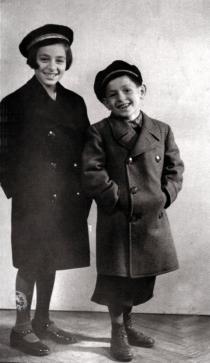Vasile Grunea's relatives in Givat Adah
This photo was taken in my uncle's garden in Givat Adah in 1955. From right to left are: my aunt Ilus Paneth and her husband Simon Sporn, next to him is his sister, my mother Erzsebet Gruber (nee Sporn), and next to her is my father, whom we didn't call by his official name, Emanuel (Gruber), in the family but simply Mano. The following is written on the back of the photo in my mother's handwriting: 'With lots of love from Erzsi (my mother), Mano (my father), Ilus (my aunt) and Simon (my uncle, whom they called Simi). I think they sent this photo to me and my family.
My uncle Simon was at least ten years older than my mother. He graduated from commercial secondary school and then from the Commercial and Agricultural Academy here in Kolozsvar. He was a clerk of a high level. In World War I he served as first lieutenant in the KuK regiment. He participated in World War I and came into contact with Zionism as a soldier. There were other Jewish officers in the army, mostly from the Austrian half of the Monarchy, who had come into contact with Zionism earlier. Simon participated in the first big Zionist meeting in 1918, in which my father, charged with propaganda, and my other uncle Marci, charged with defense, also participated. This was the rebirth of the Jewry.
Simon's future wife also came from the rabbinic family of the Paneths, she was called Ilus Paneth. Around 1922 Ilus' father, Herman Paneth, took his whole family, bought some animals and a prefabricated house and emigrated to Israel. Ilus and Simon also went with them. Herman took the prefabricated walls made in the factory in a train, then in the boat; he engaged some men, of course, to help him with the transportation. He arrived in Israel and was among the first people to found Givat Adah. This was a moshav, private property because they bought the land for it. [The moshav is a village community, in which, as opposed to the kibbutz, people own their homes and own land and can make decisions about their land independently, but at the same time, members of the moshav run the farm together and mutually help each other.]
They weren't very fortunate with the land. Coming from Transylvania, they thought that black soil was good soil, whereas in Israel red soil is usually the good soil. Black soil is usually marshland, and malaria was widespread in the region. At first they had a very hard time: the moshav wasn't going well, partly because they didn't know the climate, and partly because malaria was spreading so fast that they used to put salt on one side of the salt-cellar and quinine on the other, and they put quinine in food to avoid the shivers. Moreover the animals they took with them to Israel couldn't adapt well to the climate unfortunately and they soon died.
Simon had two children, Yitzchak and Juda [Yehuda], both born in Israel. They were sabras, that is, natives who were already born in Israel. Simon's wife came home with one of the children in the 1930s and stayed in Noszoly for a while. It wasn't easy to pay for a boat ticket, so only one of the children, who was ill, came. They were told in Israel that if they wanted to keep the child alive, they should take him to a different climate for some time. I think they spent about a year and a half here. We realized that water must have been a big problem in Israel because when the child saw a can of water, he put his arms around it and started shouting, 'All this water is mine!'. Later they returned to Israel and they were there during World War II, and both children served in the Jewish army after the war. The older one, poor Juda, died tragically on a lorry in the 1970s: they were taking boxes full of oranges, the rope broke during the loading, a box fell on him and he died. His younger brother, Yitzchak, is a farmer; he lives in Givat Adah and has three children.
























